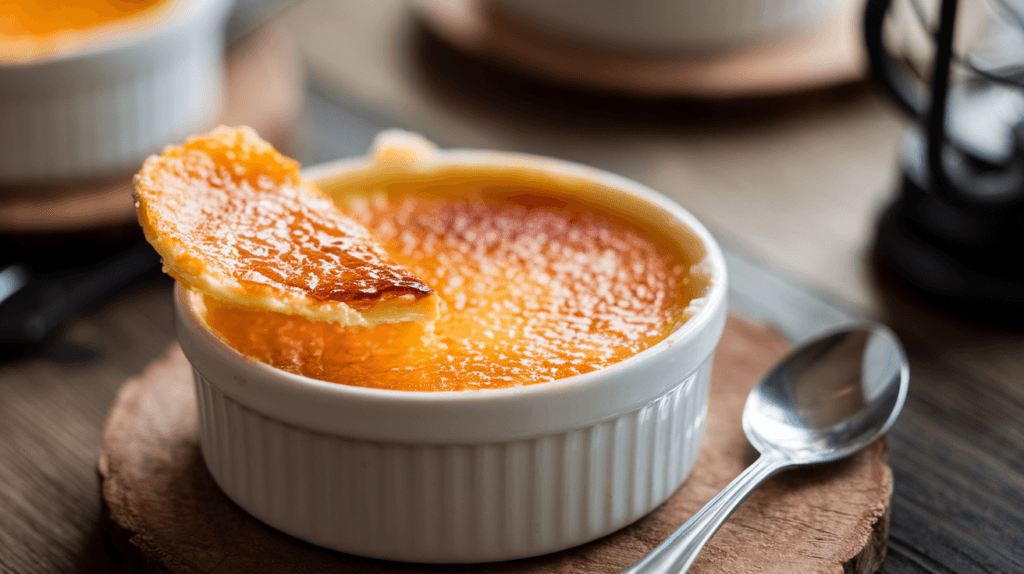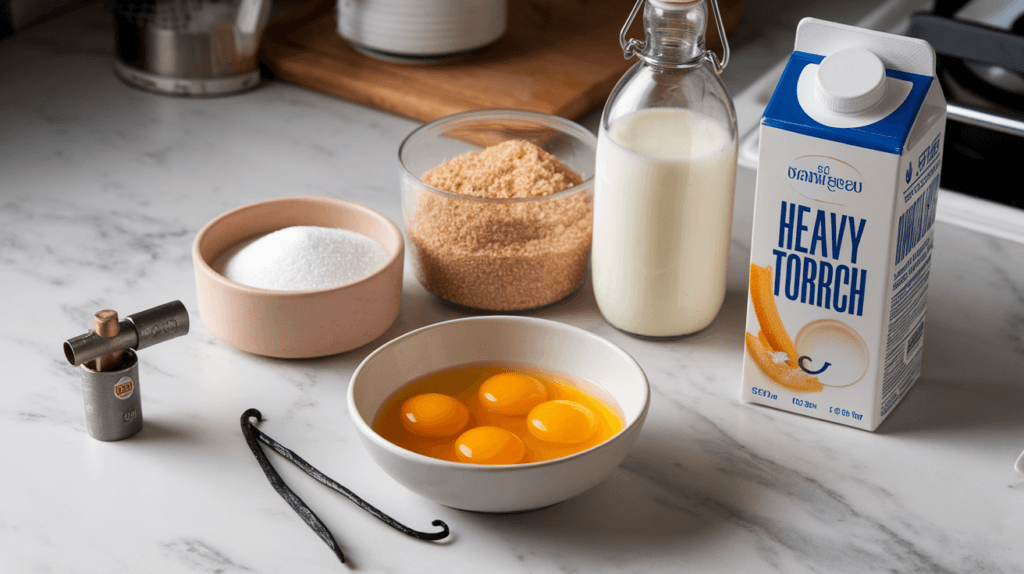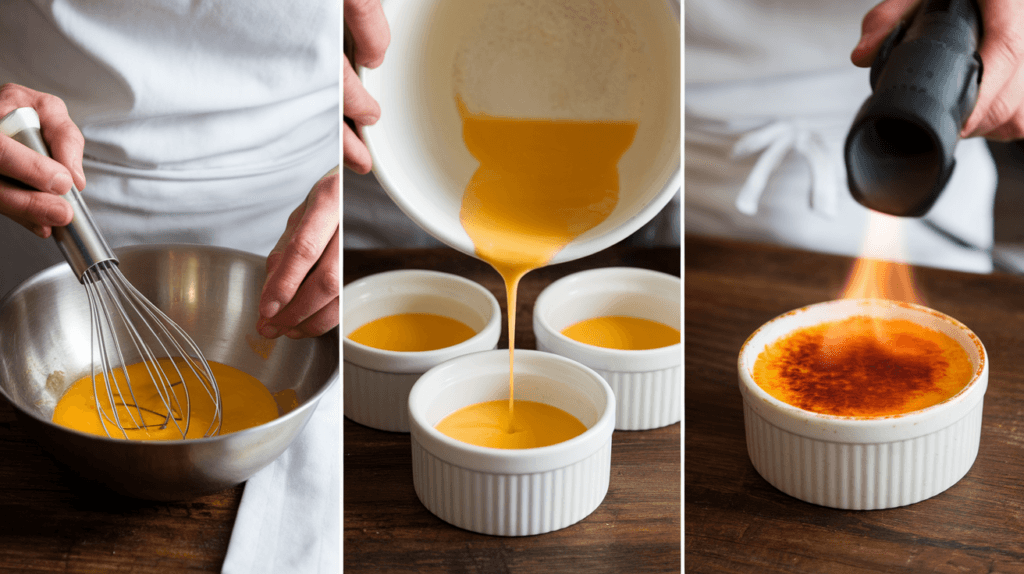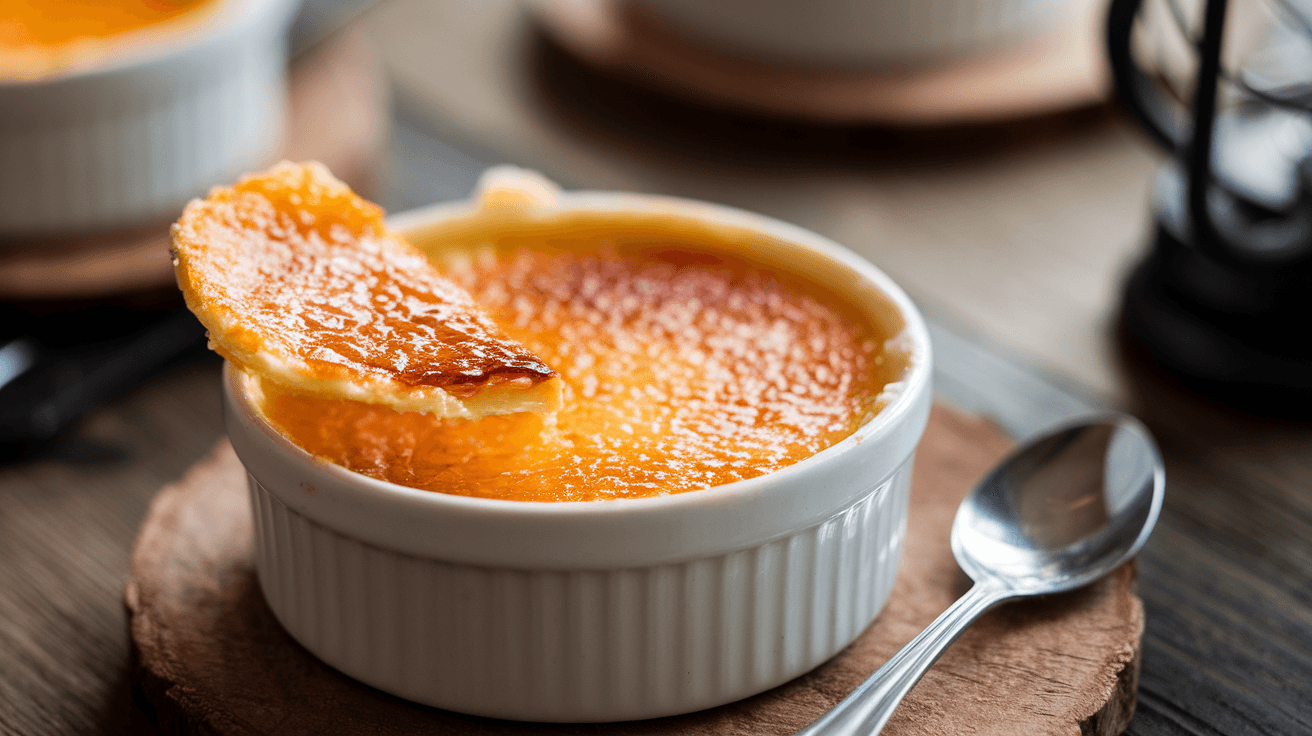Part 1: Introduction

Part 1: Introduction
Crème brûlée is one of the most iconic desserts in the culinary world, celebrated for its creamy custard base and caramelized sugar topping. Originating in France, this dessert has found its way onto menus across the globe, becoming a favorite among fine-dining enthusiasts and home bakers alike. But how much milk is in crème brûlée? This question is pivotal for those looking to understand the balance of ingredients required to achieve its luxurious texture and flavor.
While cream is traditionally the main dairy ingredient, milk can also be incorporated for a lighter variation. Understanding the exact proportions and purposes of these ingredients is key to mastering the art of crème brûlée.
In this article, we’ll explore the role of milk in crème brûlée, how much milk is typically used in recipes, and alternative approaches for those looking to experiment with or without it. From nutritional insights to step-by-step instructions, this guide will provide everything you need to craft the perfect crème brûlée to suit your taste.
Part 2: What Is Crème Brûlée?
Crème brûlée, which translates to “burnt cream” in French, is a timeless dessert that combines rich, creamy custard with a brittle layer of caramelized sugar. Its hallmark is the satisfying crack of the sugar crust, revealing the silky custard beneath. This delightful contrast of textures makes it a favorite among dessert connoisseurs.
Key Ingredients in Crème Brûlée
The simplicity of crème brûlée’s ingredients is one of its charms. At its core, the dessert includes:
- Egg yolks: Essential for creating the custard’s velvety texture.
- Sugar: Both for sweetening the custard and forming the caramelized top.
- Dairy: Heavy cream is traditionally used, although milk or a cream-milk combination can also be employed.
- Vanilla: Typically used to flavor the custard, with variations incorporating other extracts or spices.
Traditional Preparation Method
The preparation of crème brûlée involves a few precise steps to achieve its signature texture and flavor:
- Whisking the custard: Egg yolks and sugar are blended until smooth, followed by the gradual addition of warm cream or milk.
- Baking: The mixture is poured into ramekins and baked in a water bath, ensuring gentle, even cooking.
- Caramelizing the top: Once cooled, sugar is sprinkled over the surface and caramelized with a kitchen torch or broiler.
Role of Milk and Dairy in Crème Brûlée

The Purpose of Dairy
The dairy component in crème brûlée is integral to its success, as it:
- Provides richness: Cream is the traditional choice, lending the dessert its luxurious mouthfeel.
- Balances sweetness: The neutral flavor of dairy offsets the sugar, creating a harmonious taste.
- Contributes to texture: The fat in cream or milk interacts with egg yolks to form a stable, creamy custard.
Milk vs. Cream
While cream is favored for its richness, some recipes incorporate milk for a lighter texture. Milk can:
- Reduce the overall fat content of the dessert.
- Make the custard slightly less dense, appealing to those who prefer a more delicate dessert.
- Allow for variations in flavor by using different types of milk, such as whole, skim, or even non-dairy options.
Achieving the Right Texture
Balancing milk and cream is an art. A higher cream-to-milk ratio yields a thicker, richer custard, while incorporating more milk creates a custard that is lighter and slightly less indulgent. The choice depends on personal preference and dietary considerations.
How Much Milk Is Typically Used?
Standard Recipes
In traditional crème brûlée recipes, milk is often omitted entirely in favor of heavy cream. However, when milk is included, the ratio typically ranges from:
- 3 parts cream to 1 part milk: This combination ensures richness while lightening the texture slightly.
- Equal parts cream and milk: A balanced approach for those looking to reduce fat content without sacrificing too much creaminess.
Variations Across Cuisines
Different cultures and chefs may tweak the proportions of milk and cream in their crème brûlée recipes:
- French cuisine: Sticks to cream as the primary dairy component.
- American adaptations: Frequently include milk to make the recipe more accessible and less caloric.
- Modern variations: Experiment with dairy-free milks like almond or oat to cater to dietary restrictions.
Cream-to-Milk Ratios
Here are some typical ratios used in crème brûlée recipes:
| Cream-to-Milk Ratio | Effect on Texture |
|---|---|
| 100% cream | Ultra-rich and thick |
| 3:1 (cream to milk) | Rich but slightly lighter |
| 1:1 (cream to milk) | Balanced and moderately creamy |
| 100% milk | Light but less indulgent |
Each ratio has its merits, allowing for customization based on the desired result.
Part 3: Comparing Milk and Cream
Milk and cream serve as the backbone of crème brûlée’s custard, but they have distinct characteristics that affect the dessert’s flavor, texture, and overall appeal. Understanding the differences can help you decide which ingredient to prioritize or how to balance both for the best results.
Why Cream Is Preferred
Heavy cream is the traditional choice in crème brûlée recipes for several reasons:
- Richness: Cream has a higher fat content (typically 36–40%), which creates a luxurious, smooth custard.
- Stability: The higher fat content helps bind the egg yolks, ensuring a cohesive custard that doesn’t separate during cooking.
- Classic flavor: The richness of cream enhances the dessert’s decadence, aligning with its reputation as an indulgent treat.
Substituting Milk for Cream
While heavy cream is the gold standard, milk can be used as a substitute in certain circumstances:
- Reducing calorie content: Milk, especially lower-fat varieties, significantly reduces the calorie and fat content of the dessert.
- Lighter texture: Milk produces a less dense custard, appealing to those who prefer a more delicate dessert.
- Cost-effectiveness: Milk is often more affordable and accessible than heavy cream.
When substituting milk for cream, it’s essential to consider its lower fat content. Whole milk works best, as it maintains some creaminess, whereas skim milk can result in a watery, less satisfying custard.
Impact on Flavor and Texture
The choice between milk and cream affects not just the richness but also the overall mouthfeel of crème brûlée. Here’s how:
| Ingredient | Texture | Flavor |
|---|---|---|
| Heavy cream | Thick, smooth, and velvety | Rich and indulgent |
| Whole milk | Light, less dense | Mildly creamy, less rich |
| Skim milk | Thin, potentially watery | Neutral, with minimal creaminess |
| Milk-cream mixture | Balanced between richness and lightness | Moderately creamy and satisfying |
For best results, using a blend of cream and milk often provides the perfect middle ground.
Nutritional Insights
Calories and Fat Content in Traditional Recipes
Crème brûlée is undeniably a treat, but understanding its nutritional profile can help you make informed choices. A standard serving of crème brûlée made with heavy cream includes:
- Calories: Approximately 250–300 per serving.
- Fat: About 20–25 grams, with most of it coming from the cream.
- Protein: 4–5 grams, primarily from the egg yolks.
- Carbohydrates: 20–25 grams, contributed by the sugar.
Using milk instead of cream reduces the fat content significantly but may slightly increase carbohydrates due to the natural sugars in milk.
Health-Conscious Adjustments
For those looking to enjoy crème brûlée with fewer calories or less fat, consider the following adjustments:
- Substitute part of the cream with milk: A 50:50 ratio balances richness with lower calorie content.
- Opt for plant-based milks: Unsweetened almond or coconut milk can replace dairy for a vegan or dairy-free option.
- Reduce sugar: Cutting back on sugar in the custard mixture can make the dessert less caloric without sacrificing flavor.
Balancing Flavor with Nutritional Goals
While it’s tempting to prioritize health over indulgence, the charm of crème brûlée lies in its richness. Experiment with small adjustments rather than overhauling the recipe entirely to preserve the dessert’s authentic essence.
Crème Brûlée Without Milk
For those avoiding milk due to dietary restrictions or personal preference, there are several ways to enjoy crème brûlée without compromising too much on flavor and texture.
Dairy-Free Alternatives
Substituting milk or cream in crème brûlée is easier than it sounds, thanks to the availability of plant-based options. Popular choices include:
- Coconut milk or cream: Offers a rich texture and a subtle coconut flavor that pairs well with vanilla.
- Almond milk: Provides a light, nutty flavor, though it’s less creamy than dairy options.
- Oat milk: A thicker plant-based milk that mimics the texture of cream fairly well.
Plant-Based Tips for Success
When using plant-based milk, keep the following in mind:
- Thickeners may be needed: A small amount of cornstarch or arrowroot powder can help stabilize the custard.
- Adjust sweetness: Many plant-based milks are slightly sweetened, so reduce the added sugar in your recipe accordingly.
Maintaining Texture Without Dairy
The creamy consistency of crème brûlée relies on the balance of proteins and fats in the custard. When eliminating milk, consider:
- Adding extra egg yolks: To compensate for the lack of fat in non-dairy milks.
- Baking carefully: Use a water bath to prevent curdling and ensure even cooking.
By exploring these alternatives, you can create a delicious crème brûlée that suits various dietary needs while retaining its signature charm.
Part 4: Step-by-Step Recipe with Milk

While traditional crème brûlée recipes rely on heavy cream, incorporating milk is a great way to lighten the dessert. Below is a detailed recipe that uses a combination of milk and cream to achieve a balanced texture and flavor.
Ingredients
To make crème brûlée with milk, gather the following:
- 4 large egg yolks: Provides the custard base.
- 1/4 cup granulated sugar: Sweetens the mixture.
- 1 cup heavy cream: Adds richness.
- 1/2 cup whole milk: Balances the richness with a lighter touch.
- 1 teaspoon vanilla extract: Enhances flavor.
- 1/4 cup granulated sugar: For the caramelized topping.
Preparation Instructions
- Preheat and Prepare Ramekins
- Preheat your oven to 325°F (160°C).
- Arrange 4–6 ramekins in a baking dish large enough to hold them without touching.
- Warm the Dairy Mixture
- In a medium saucepan, combine the heavy cream and milk.
- Heat over medium-low until the mixture is warm (do not boil). Remove from heat.
- Whisk the Egg Yolks and Sugar
- In a separate bowl, whisk the egg yolks and 1/4 cup sugar until pale and smooth.
- Combine and Flavor
- Gradually add the warm milk-cream mixture to the egg yolk mixture, whisking constantly to prevent curdling.
- Stir in the vanilla extract.
- Strain the Mixture
- Pour the custard through a fine-mesh sieve to remove any cooked egg bits, ensuring a silky texture.
- Pour and Bake
- Divide the mixture evenly among the ramekins.
- Pour hot water into the baking dish until it reaches halfway up the sides of the ramekins.
- Bake for 30–40 minutes, or until the custard is set but still jiggles slightly in the center.
- Cool and Chill
- Remove ramekins from the water bath and let them cool to room temperature.
- Cover and refrigerate for at least 4 hours or overnight for the best texture.
- Caramelize the Sugar
- Just before serving, sprinkle 1–2 teaspoons of granulated sugar evenly over the top of each custard.
- Use a kitchen torch to caramelize the sugar, creating a golden, glassy crust.
Adjustments for Milk Usage
- For a richer custard: Use a ratio of 3 parts cream to 1 part milk.
- For an even lighter custard: Swap the cream entirely for whole milk, but expect a less indulgent texture.
Common Mistakes When Using Milk
Even with the best recipe, mistakes can happen. Here’s how to avoid common pitfalls when making crème brûlée with milk:
1. Overheating the Milk
Milk heats more quickly than cream, so it’s important to avoid boiling it. Boiling can cause curdling or a scorched flavor.
Solution: Heat the milk gently and monitor it closely.
2. Skipping the Water Bath
The water bath (or bain-marie) is essential for even cooking. Without it, the custard may bake unevenly, leading to a cracked surface or curdled texture.
Solution: Always use a water bath and ensure the water is hot before placing the baking dish in the oven.
3. Improper Sugar Caramelization
Using milk in the custard can make the surface more sensitive to heat. Over-caramelizing the sugar can result in a burnt, bitter taste.
Solution: Keep the torch moving in circular motions and avoid concentrating heat in one spot for too long.
4. Using Low-Fat Milk
Skim or low-fat milk lacks the fat necessary for a smooth custard.
Solution: Stick to whole milk or combine milk with cream for a richer result.
5. Overbaking the Custard
Baking the custard for too long or at too high a temperature can cause it to become grainy.
Solution: Remove the custard from the oven when the edges are set, but the center still jiggles slightly.
Part 5: Popular Variations of Crème Brûlée
Crème brûlée is beloved for its simplicity, but chefs and home bakers alike often experiment with flavors to create exciting variations. These versions can range from subtle twists to bold reinterpretations, appealing to a wide range of palates.
1. Classic Vanilla Crème Brûlée
The traditional version of crème brûlée highlights the elegance of simple ingredients.
- Flavor Base: Pure vanilla extract or vanilla bean seeds.
- Enhancements: The use of a whole vanilla bean adds flecks of seeds throughout the custard, intensifying its aroma.
- Pairing Ideas: Best served with fresh berries or a crisp biscotti.
2. Chocolate Crème Brûlée
For chocoholics, this decadent variation is a must-try.
- How It’s Made: Melted dark chocolate is whisked into the custard base before baking.
- Taste Profile: Rich and bittersweet with a smooth texture.
- Serving Tip: Garnish with a dollop of whipped cream or chocolate shavings.
3. Coffee or Espresso Crème Brûlée
This version is perfect for coffee lovers, offering a deep, aromatic flavor.
- How It’s Made: Brewed espresso or instant coffee powder is added to the cream-milk mixture.
- Pairing Ideas: Pairs beautifully with almond biscotti or caramel drizzle.
4. Matcha Crème Brûlée
For those seeking a unique and trendy twist, matcha (green tea powder) delivers both flavor and visual appeal.
- How It’s Made: Matcha is whisked into the dairy mixture before blending with the egg yolks.
- Taste Profile: Earthy and slightly bitter, balanced by the sweetness of the custard.
- Presentation: A vibrant green hue that makes it a showstopper on the table.
5. Fruit-Infused Crème Brûlée
Infusing the dairy with fruit flavors introduces a refreshing twist to the dessert. Popular choices include:
- Citrus Zest: Lemon or orange zest for a zesty tang.
- Berry Puree: Raspberry, strawberry, or blueberry puree swirled into the custard.
- Tropical Notes: Coconut milk with a touch of pineapple or mango.
6. Lavender or Floral Crème Brûlée
Delicate floral notes can elevate the dessert into something truly sophisticated.
- How It’s Made: The cream is infused with dried lavender, rosewater, or orange blossom water.
- Serving Idea: Garnish with edible flowers for a visually stunning presentation.
The Science Behind the Custard
To fully appreciate the art of crème brûlée, it helps to understand the science behind its creamy texture and caramelized topping.
How Proteins and Fat Work Together
- Proteins in Egg Yolks: When heated, the proteins in egg yolks coagulate, transforming the liquid custard mixture into a solid structure.
- Role of Fat: Fat from milk or cream creates a smooth, luscious texture by coating the proteins, preventing a grainy consistency.
Why Low-Temperature Baking Is Essential
Crème brûlée requires gentle heat to cook evenly without curdling. Baking at a low temperature in a water bath ensures the custard sets slowly, maintaining its silky texture.
Caramelization: The Perfect Finish
- What Happens: The sugar on top melts under high heat, breaking down into simple compounds that form a golden, glassy crust.
- Tips for Success: Use fine sugar for an even caramelization, and ensure the custard is fully chilled before torching the sugar to avoid melting the custard underneath.
Equipment Needed for Crème Brûlée
Mastering crème brûlée is easier with the right tools. Here’s what you’ll need:
1. Ramekins
- Small, oven-safe dishes that hold individual portions of custard.
- Size: Typically 4–6 ounces per serving.
2. Baking Dish
- A large dish for creating a water bath to ensure even cooking.
3. Fine-Mesh Sieve
- Essential for straining the custard mixture and removing any lumps or egg solids.
4. Kitchen Torch
- The most efficient way to caramelize the sugar topping.
- Alternatives: If a torch isn’t available, a broiler can be used, but watch carefully to prevent burning.
5. Whisk and Mixing Bowls
- For blending the custard ingredients smoothly and evenly.
Part 6: FAQs About Crème Brûlée and Milk
To address common questions and concerns about crème brûlée, especially regarding the use of milk, here are some frequently asked questions and their answers.
1. Is Milk Necessary in Crème Brûlée?
Milk is not a necessity in traditional crème brûlée recipes, which usually rely solely on heavy cream for richness. However, milk can be included to lighten the dessert or reduce its fat content. Combining cream and milk allows you to adjust the texture and richness to your liking.
2. Can You Use Skim Milk in Crème Brûlée?
While it is possible to use skim milk, the resulting custard may lack the creamy texture associated with crème brûlée. Skim milk’s low fat content often results in a thinner custard, so it’s best to use whole milk or mix skim milk with some cream for better results.
3. What Is the Best Milk-to-Cream Ratio?
The ideal ratio depends on your preference for richness:
- For a rich, traditional texture: Use 100% heavy cream.
- For a balanced custard: Use a ratio of 3 parts cream to 1 part milk.
- For a lighter custard: Equal parts cream and whole milk work well.
4. Can Non-Dairy Milk Be Used in Crème Brûlée?
Yes, non-dairy milks such as almond, coconut, or oat milk can replace dairy milk. Coconut milk is particularly popular for its rich, creamy consistency, while almond and oat milk provide a lighter texture. Ensure that your non-dairy option is unsweetened to avoid altering the dessert’s flavor balance.
5. Why Does My Custard Curdle When Using Milk?
Curdling occurs when the custard is exposed to high heat, causing the proteins in the milk and egg yolks to coagulate too quickly. This is more common with milk because of its lower fat content.
Solution: Bake at a low temperature in a water bath, and avoid boiling the milk before combining it with the egg yolks.
6. Can I Make Crème Brûlée Without a Torch?
Yes! If you don’t have a kitchen torch, you can use your oven’s broiler to caramelize the sugar topping:
- Place the ramekins on a baking sheet.
- Sprinkle an even layer of sugar on top of each custard.
- Broil on high for 2–3 minutes, keeping a close eye to prevent burning.
Cultural Variations of Crème Brûlée
Crème brûlée’s popularity extends beyond France, and variations have emerged in different cultures, each adding its own twist to the classic dessert.
1. French-Style Crème Brûlée
- Rich and indulgent, relying entirely on cream.
- Flavored primarily with vanilla or subtle additions like orange zest.
2. American Adaptations
- Often includes milk to lighten the custard and reduce fat content.
- Incorporates bold flavors like bourbon, pumpkin spice, or chocolate.
3. Asian Twists
- Incorporates flavors such as matcha (Japanese green tea) or yuzu (a citrus fruit).
- Some recipes use coconut milk, especially in Southeast Asia, to complement tropical flavors.
4. Spanish and Portuguese Influences
While similar in appearance, Spanish crema catalana and Portuguese leite creme often substitute milk for cream entirely and use cinnamon or lemon as the primary flavoring.
Conclusion
Crème brûlée is a dessert steeped in tradition yet flexible enough to accommodate a wide range of preferences and dietary needs. While cream is the classic choice for creating its rich and silky texture, incorporating milk allows for a lighter, more accessible version of this beloved treat. By understanding the roles of milk and cream, experimenting with different ratios, and exploring creative variations, you can master the art of crème brûlée and adapt it to suit any occasion.
Whether you’re crafting a decadent vanilla custard or experimenting with non-dairy alternatives, the secret to perfect crème brûlée lies in balancing flavor, texture, and technique. With this comprehensive guide, you’re well-equipped to enjoy the journey from kitchen to table, cracking into a dessert that’s as rewarding to make as it is to eat.

